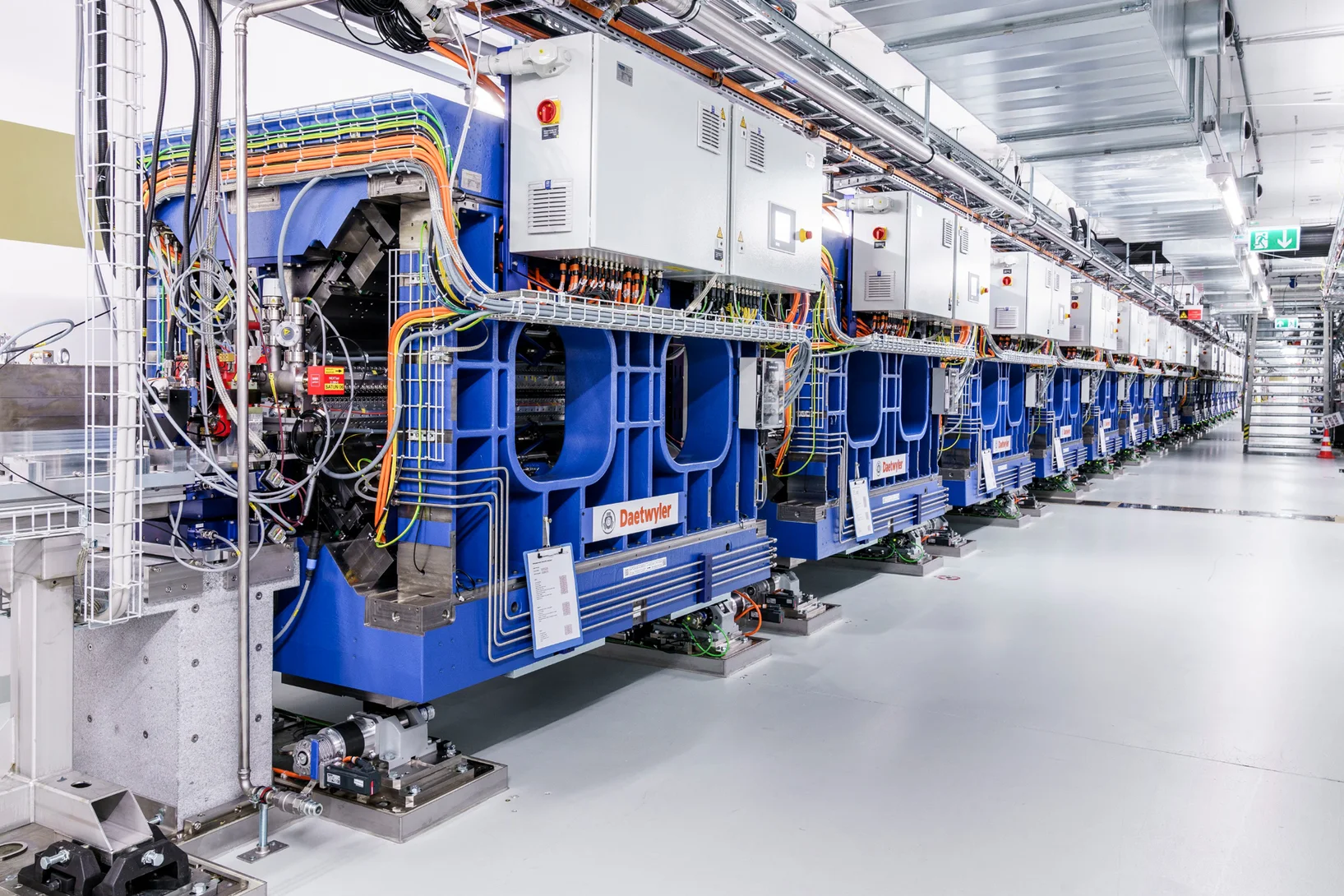The latest large research facility at PSI generates very short pulses of X-ray light with laser-like properties. This enables researchers to observe extremely fast processes, such as how new molecules are created in a chemical reaction; to determine the detailed structure of vital proteins; or to determine the relationship between electronic and atomic structure in materials. This new knowledge expands our understanding of nature and leads to many practical applications, for instance new pharmaceuticals, more efficient processes in the chemical industry, or new materials for electronics.
How the SwissFEL works
The facility is 740 metres long and composed of four sections: Injector with electron source, linear accelerator, an arrangement of undulators, and experimental facilities.
The SwissFEL is a X-ray free-electron laser (the FEL in its name stands for Free Electron Laser), which delivers extremely short and intense flashes of X-ray radiation of laser quality. The flashes are only 1 to 60 femtoseconds in duration (1 femtosecond = 0,000 000 000 000 001 second). These properties enable novel insights into the structure and dynamics of matter illuminated by the X-ray flashes.
The creation of the X-rays begins at the electron source: Electrons are initially set free when a burst of light strikes a metal plate. They are then brought to the high velocity required by means of an electric field in a linear accelerator. In this process, the electrons acquire as much energy as if they had crossed a voltage of 6 billion volts. They are then fast enough to be fed into a snake-like path along undulators – as the long magnet array used is called by specialists. Along their path, the electrons create X-rays, which amplify like an avalanche, producing the uniquely intense X-ray radiation of the SwissFEL. 12 undulators, each having 1060 magnets, are arranged one behind another over 60 metres at the SwissFEL.
The X-ray beam is then routed to the experimental location, where it is available for researchers' experiments.
New findings for science, technology and medicine
The X-ray pulses are so powerful that they can be used to create films of the motion of atoms and molecules. At the SwissFEL it is possible, for example, to follow step-by-step how the smallest components of a substance separate during a chemical reaction and then recombine to create a new substance. These processes are so fast that they could only be observed with difficulty. However, the extremely short flashes of the SwissFEL make it possible to take a snapshot of the individual intermediate steps by means of its extremely short exposure time. A more precise understanding of this sequence of events can help to make processes in the chemical industry more efficient and therefore more efficient in the use of basic resources.
At the SwissFEL it is also possible to determine in detail how vital biological molecules are built up. Such molecules are composed of tens of thousands of atoms, and it is crucial for their functioning that the atoms are correctly arranged. This knowledge could be the basis for new pharmaceuticals, in that they could show, for example, how important biological processes can be suppressed in pathogenic bacteria.
Location and surroundings
The SwissFEL is located in the Würenlingen forest, adjoining the existing PSI site in the Swiss Canton of Aargau. After comprehensive analysis, this location proved to be the one most suitable. Here, the temperature variations and ground vibrations are particularly low, which is essential for the successful operation of this high-precision facility. SwissFEL's close proximity to the present PSI site will allow the Institute's existing infrastructure to be used. Most of the building was covered by soil and gravel, creating a natural habitat for threatened plants and animals.
Further information
- Homepage of the SwissFEL project
- Film of the new large research facility SwissFEL
- Camera ride through the SwissFEL
News
Synchronising ultrashort X-ray pulses
Attosecond coherent pulses at SwissFEL will open new experimental possibilities
Disorder begins at the surface of quantum materials
Ultrafast X-rays from SwissFEL reveal unexpected light responses in quantum materials.
Topological defects determine evolution of charge density wave phase transition
Total scattering signals collected at SwissFEL reveal the role of topological defects when switching properties of a charge density wave material. The defect formation and dynamics after laser excitation reveals new insights into the functionality of quantum materials.







